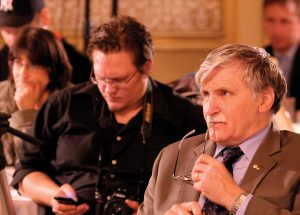
In the ten years since the birth of the Responsibility to protect report, media technology has advanced by leaps and bounds, but also faced cutbacks, which has impeded their ability to cover international conflicts.
That set the framework for the Promise of the Media in Halting Mass Atrocities: A Conference to Mark the 10th Anniversary of the Responsibility to Protect, presented by the Montreal Institute for Genocide and Human Rights Studies.
Sitting at the front of a conference room in the swanky Mount Stephen Club, Senator Roméo Dallaire and Andrew Potter, the online politics editor at the Ottawa Citizen, traded words with chair and host of the CBC’s As It Happens Carol Off in a panel about the link between news media and governmental leadership.
The conference brought politicians and journalists into the same room, not at loggerheads, but looking to map out the potential of media to avert mass atrocities. Off questioned that premise, however, in a bid to offer a “reality check” to the tone of the conference.
“The promise of the media [to prevent mass atrocities] is really not there and that’s not because we don’t really care […] and in some cases we can not even be there because of the cutbacks in foreign coverage that all media including the public broadcasters are experiencing, but it’s not the role of journalists to do that,” she said. “We don’t have a vested interest in how stories conclude. We serve the public best when we are disinterested and we’re doing our job.”
Dallaire also had some questions about the topic of the panel.
“I’m not sure there is a link there. I would contend that there is a wall there between the media and the government leadership. The question is, are you breaking down the wall, are you going around it, or are you being stymied by that wall? You, the politician, and you, media news person, both in this context in our democratic process,” he asked.
The premise of the responsibility to protect is a commitment to protect people from genocide, war crimes, ethnic cleansing and crimes against humanity, according to the R2P movement’s website.
Off, pointing out that the first tenet of the responsibility to protect is that the government of the country in conflict should be the agent of its own change, believes the future of ongoing coverage in conflict zones lies with the local journalists.
Potter added that the best thing that happened to him during his visit to Afghanistan was a tour of the local newsroom, and suggested that instead of sending journalists to cover conflicts abroad, that the reverse happen: that local journalists be flown in to speak to journalists in Canadian newsrooms.
Dallaire also had some choice words of advice for the journalists covering conflict zones. The media of the new millennium has undergone a radical change compared to the previous decade, but even in his experience in the field in the 1990s, Dallaire said he rubbed shoulders with journalists who had “no idea” what they were doing in the field.
The new journalist must equip themselves with in-depth knowledge in the soft sciences or risk being “completely out of their league” when covering conflicts abroad, Dallaire said.
“If you are going to influence policy, you’re going to need a whole new capability,” he said.





Comments are closed.